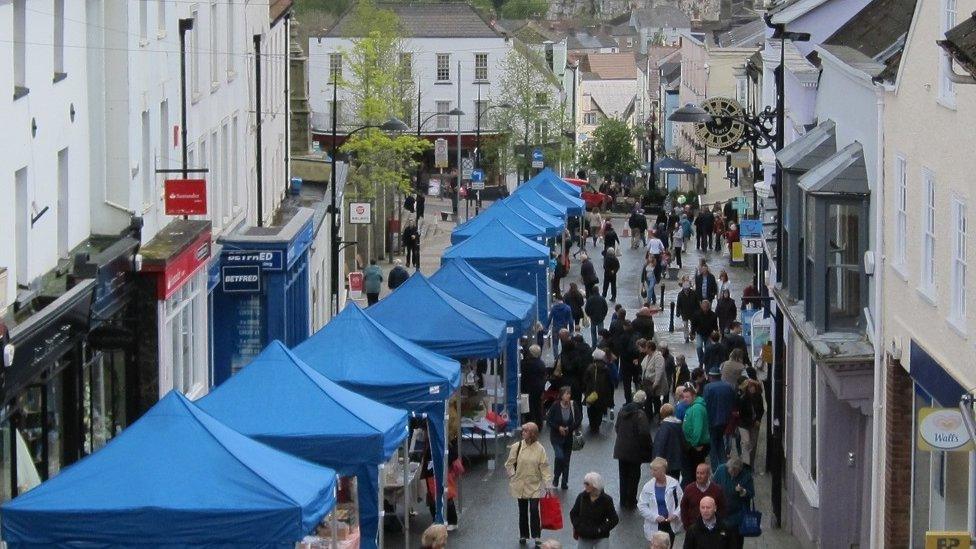Chepstow: Town steeped in history celebrates 950 years
- Published

Chepstow is celebrating its maritime history with a year of events
How much do you know about the sleepy town of Chepstow, nestling on the banks of the River Wye?
Almost certainly the answer is not as much as you think.
But the people of the town are hoping all that is about to change, as they prepare to embark on a year of celebrations to mark the 950th anniversary of it being founded.
Picnics, lectures and pageants will tell the story of battles, castles and bridges which made this small Monmouthshire town a leading force in engineering advances now echoed across the globe.

Chepstow Castle was the "space race of its day" in terms of its design
The area has been occupied continuously since at least the Mesolithic Period of about 5,000 BC, through the Iron Age, and up to the Silures tribe, who put up fierce resistance to the early Roman invasion.
But it was with the arrival of the Normans that the area took on huge strategic importance.
Less than six months after the Battle of Hastings, William The Conqueror's right-hand man, William FitzOsbern, was dispatched to secure the western-most fringes of the occupation from the marauding Welsh.
For the site of his first castle he picked Chepstow - named Striguil by the Normans - as it was the lowest bridging point of the River Wye and close to its confluence with the Severn.
Local historian John Burrows said the stronghold was an early example of "shock and awe" and "the space-race" of its day.
"From the outset Chepstow Castle was intended to be a statement as much as a fortification, to a people who would probably never have seen a stone building before," he said.
"A wooden castle would have done the job just as well, but he wanted to prove the military and technological dominance of the Normans without having to go to battle."
A market, port wall and town gate, and the first of its many bridges came during the 12th and 13th centuries, transforming Chepstow into Wales' largest medieval port.
It was a title which Chepstow would hold right up to the end of the Napoleonic Wars.
From ships to wind power
From 1790 to 1795 the port handled more shipping than Swansea, Cardiff and Newport put together, with vessels leaving Chepstow for Iceland, Turkey, Italy, France and Portugal.
Chepstow's dominance was only halted by the Industrial Revolution.
Swansea and Cardiff were much better suited to transport coal due to tidal issues and the invention of larger ships, and so Chepstow re-invented itself as a ship-building community.
"The shipyard produced light-weight, low-cost, pre-fabricated ships which could be floated down the river and assembled elsewhere," said Mr Burrows.
"That led to bridge building, and eventually to the construction of wind turbines, which sadly ceased in 2015. "

The Grade I listed Chepstow Bridge played a crucial role in uniting south Wales with the West Country, until the Severn Bridge opened in 1966
In 1816 the Grade I listed Chepstow Bridge began the town's legacy for bridge building which would put it on the engineering map.
Built by John Urpeth Rastrick, it remains the only five-arch bridge of its kind to survive.
In 1966 the Severn Bridge opened. Using much thinner "aero-deck" the platform was much more stable and revolutionised suspension bridges all over the world.
The town's connection with bridges is celebrated each January with Welsh Mari Lwyd's face-off against English wassailers on the Old Wye Bridge.

Chepstow Bridge
Chepstow was also home to Britain's first black high sheriff. In 1794 St Kitts slave-turned-slave-owner Nathaniel Wells set up home at Piercefield estate, now the site of the racecourse, before becoming only the second black man to hold a commission in the British Army.
Today the town is twinned with Cormeilles, the Normandy home of William FitzOsbern. An arrangement dating back to 1976.
Mr Burrows said Chepstow should look to the French commune to bring people back to the town centre.
"Chepstow has been an important part of the Wye tourist trail since the 18th Century, but visitors tend to go to the castle and on to Tintern Abbey, missing out the town centre," he said.
"Part of the problem is that most of the shops and bars are at the top of a steep hill, so maybe some sort of funicular system might encourage visitors into the town, and itself become a tourist attraction."

Chepstow could learn a lot about tourism from its twinning partner in France
- Published28 July 2015

- Published24 July 2016

- Published2 March 2017
